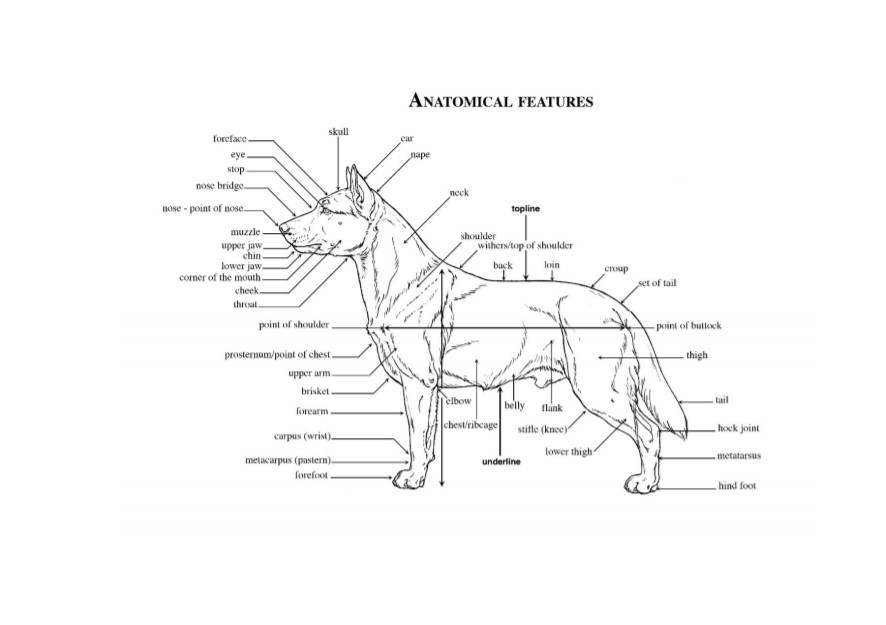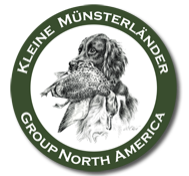FEDERATION CYNOLOGIQUE INTERNATIONALE (AISBL)
SECRETARIAT GENERAL: 13, Place Albert 1er B – 6530 Thuin (Belgique) __________________________________________________________________
14.11.2019/ EN
FCI-Standard N° 102
KLEINER MÜNSTERLÄNDER
TRANSLATION: Elke Peper. Revised by Ken Bremer / Official language (DE).
COUNTRY OF ORIGIN: Germany.
DATE OF PUBLICATION OF THE OFFICIAL VALID STANDARD: 04/09/2019.
UTILIZATION: Versatile working gundog.
FCI-CLASSIFICATION: Group 7 Pointing Dogs. Section 1.2 Continental Pointing Dogs. Spaniel Type. With Working Trial.
A BRIEF HISTORICAL SUMMARY: The breeding of this breed in the north German Münsterland has been documented since around 1870. The blood of hundreds of years of old flushing and pointing dogs flowed in the Kleiner Münsterländer.
In 1912, the “Association for Kleine Münsterländer Poining Dogs (Heidewachtelhunde)” was founded in the parent country Germany to preserve and promote these dogs as an independent hunting breed. Hunters were to be provided with a medium-sized, passionate, intelligent and affectionate, fully versatile hunting dog in the field, forest and water. In 1921, Dr. Dr. Friedrich Jungklaus created the first breed standard, which has been regularly enhanced since then. Today, the Kleiner Münsterländer is a versatile hunting dog that is very popular with hunters worldwide because of its performance capabilities.
GENERAL APPEARANCE: Strong and harmonious build of medium size, showing balanced proportions with a lot of quality and elegance. Distinguished head. In upright posture the dog displays flowing outlines with horizontally carried tail. Its front legs are well feathered, the hind legs with breeches, the tail has a distinct flag.
Its glossy coat should be straight or slightly wavy, dense and not too
long. Its movement is harmonious and far reaching.
The overall appearance of the breed must always show its utility as a hunting dog.
IMPORTANT PROPORTIONS:
The length of the body, measured from the prosternum to the point of the buttock, should exceed the height at the withers. The goal is a ratio 1 to 1.1.
The length of the skull from the occiput to the stop is equal to the length of the muzzle from the stop to the nose. The distance from the ground to the elbows should be approximately equal to the distance from the elbows to the withers.
BEHAVIOUR / TEMPERAMENT: The Kleiner Münsterländer is intelligent and capable of learning, full of temperament but even, with steady character; its attitude towards people is alert and friendly (suitable for family life), with good social behaviour and keeps close contact with his master (team spirit); with passionate, persevering predatory instinct, versatile hunting aptitudes and strong nerves and keenness for game.
The dog must have the natural abilities required to hunt in close cooperation with its handler in the field, forest and water (versability), and to retrieve game to the hunter.
HEAD: The expression of the head is part of the type.
CRANIAL REGION:
Skull: Distinguished, lean, flat to slightly arched.
Stop: Only slightly pronounced but distinctly recognizable.
FACIAL REGION:
Nose: Whole coloured brown.
Muzzle: Powerful, long, straight.
Lips: Short, tight closing, well pigmented – whole coloured brown.
Jaws / teeth: Large white teeth. Powerful jaws with regular and complete scissor bite with the upper teeth closely overlapping the lower teeth and set square to the jaws. 42 teeth according to the dentition formula. An over- or under number of 2 x P1 is permissible.
Cheeks: Strong, well-muscled.
EYES: Of medium size, neither protruding nor deep set. As dark brown as possible. Eyelids tight fitting to the eyeballs, covering the haws.
EARS: Broad, set on high, lying close to the head, tapering towards the tips, ear leather should not reach beyond the corner of the mouth.
NECK: Its length in balance with the general appearance; gradually widening towards the body. Napeline slightly arched, very muscular. Tight fitting throat skin.
BODY:
Topline: Slightly sloping in a straight line.
Withers: Pronounced.
Back: Firm, well-muscled. The spinal processes should be covered by the musculature.
Loins: Short, broad, muscular.
Croup: Long and broad, not short slanting, only slightly sloping towards the tail; well-muscled. Broad pelvis.
Chest: Rather deep than broad, breastbone reaching as far backwards as possible. Ribs well arched.
Underline and belly: Slight tuck-up towards the rear in an elegant curve; lean.
TAIL: Set on high, with long flag following the topline, strong at the base, then tapering. Of medium length. Carried downwards in repose, horizontally and not too high above the level of the topline with a slight sweep when in action. In the lower third it may be curved slightly upwards.
LIMBS:
FOREQUARTERS:
General appearance: Viewed from the front straight and rather parallel, viewed from the side legs set well under the body. The distance from the ground to the elbows should be approximately equal to the distance from the elbows to the withers.
Shoulders: Shoulder blades lying close to the body, strongly muscled. Shoulder and upper arm forming a good angle of approximately 110°.
Upper arm: As long as possible, well-muscled.
Elbows: Close to the body, neither turning in nor out. The upper arm forming a good angle with the forearm.
Forearm: Strong bones, perpendicular to the ground.
Carpal joint: Strong.
Pasterns: Very slightly sloping.
Front feet: Round and arched with well-knit toes and sufficiently thick, tough, robust pads. Not too heavy coat. Parallel in stance or in movement, neither turning in nor out.
HINDQUARTERS:
General appearance: Viewed from the rear straight and parallel. Correct angulation in stifles and hocks. Strong bones.
Upper thigh: Long, broad, muscular; forming a good angle with the pelvis.
Stifle: Strong, upper and lower thigh forming a good angle.
Lower thigh: Long, muscular and sinewy.
Hock joint: Strong.
Metatarsus: Short, perpendicular to the ground.
Hind feet: Round and arched with well-knit toes and sufficiently thick, tough, robust pads; not too heavy coat. Parallel in stance or in movement, neither turning in nor out.
GAIT / MOVEMENT: Ground covering, with good drive and appropriate reach, straight forward and parallel coming and going, with well upstanding posture. Pacing gait is undesirable.
SKIN: Tight fitting, without folds.
COAT:
Hair: Dense, of medium length, not or only slightly wavy, close lying, water-repellent. The outlines of the body may not be hidden by too long coat. By its density it should provide as good a protection against weather, unfavourable terrain conditions and injuries as possible. Short smooth coat on the ears is faulty. Forelegs feathered, hindlegs with breeching down to the hocks, tail with a long flag and white tip, abundant coat on the fore chest is undesirable.
Colour: Brown-white or brown roan with brown patches, brown mantle or brown ticking; blaze permitted. Tan coloured markings on the muzzle, the eyes and around the anus, and on the ears, tail and legs are permissible („Jungklaus markings “).
SIZE:
Height at withers: Dogs: 54 cm.
Bitches: 52 cm.
A deviation of +/- 2 cm is within the standard.
FAULTS: Any departure of the foregoing points must be considered a fault and the seriousness with which the fault should be regarded should be in exact proportion to its degree and its effect upon the health and welfare of the dog.
SEVERE FAULTS:
- Clumsy, big-boned conformation.
- Serious deviations from the correct proportions of body, neck and height and withers.
- More than 50% of the nose flesh-coloured or spotted.
- Pointed muzzle. Dished nose bridge.
- Eyes too light.
- Croup too short
- Serious lack of depth of chest or too flat sided brisket. Barrel shaped brisket.
- Elbows heavily turning out or in.
- Steep pasterns.
- Strongly cow hocked or barrel legged, in stance as well as in movement.
- Splayed toes; flat feet.
- Clumsy movement.
- Smooth hairless ears or too long and curled fringes on the ears.
- Coat too curled.
- Deviation of the size limits between +/-2cm and +/- 4cm.
DISQUALIFYING FAULTS:
- Aggressive or overly shy dogs.
- Any dog clearly showing physical or behavioural abnormalities.
- Fearfulness, aggressiveness, game or gun shyness.
- Gross deviations. From the gender type, sexual malformations.
- Completely depigmented nose.
- All deviations from the correct scissor bite except the lack or excess of two P1.
- Split jaw or split lip.
- Bird’s eye.
- Ectropion, entropion, distichiasis, (double eyelash line).
- Pronounced dewlap.
- Distinct roach back,
- Pronounced swayback; crooked spine.
- Malformation of the ribcage, e.g. sternum cut off.
- Kinky tail, ring tail, other tail abnormalities e.g. too short or too long tail.
- Wholecoloured dogs.
- Deviation in height of more than +/-4 cm.
N.B.:
- Male animals should have two apparently normal testicles fully descended into the scrotum.
- Only functionally and clinically healthy dogs, with breed typical conformation should be used for breeding.
The latest amendments are in bold characters.


